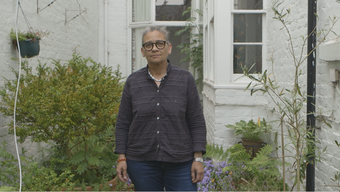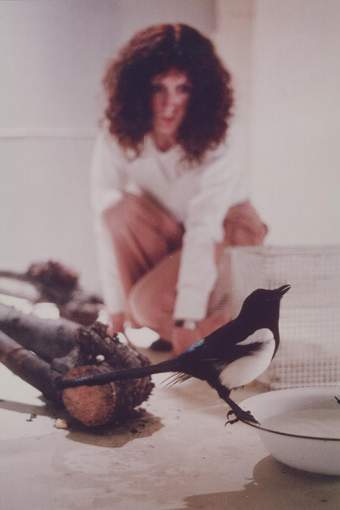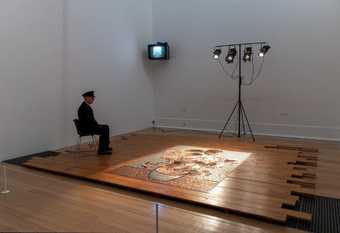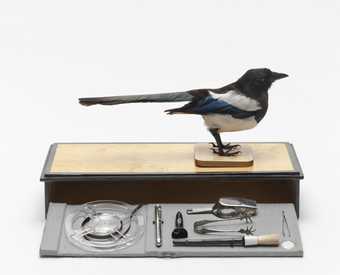[Beep]
Rose Finn-Kelcey: I think it's important to be mischievous If there isn't any humour in the work then I feel something's wrong.
Andrew Wilson: Rose Finn-Kelcey was an artist. She was born in 1945 and I died in 2014. The nature of work that Rose Finn-Kelcey made throughout her career was very diverse. Its diverse in terms of subject, and style. I mean this is work that in a way is recognisably by one artist.
It has a consistent vision to it but in another way it could almost be made by any number of different artists
Andree Cooke: She was interested in using a whole range of materials. Very rarely did she come back to using a material again and again. So there was an engagement really with ideas at the core of everything she made, and then thinking about how materials could best express what she wanted to communicate.
AW: She is a very substantial artist. But her status, like the status of so many artists, is one that's defined by the marketplace. And if you're an artist making work that is installation based or performance based then it's very difficult for work such as that to be traded. And that is also a very conscious decision. And I think that's something that's at the heart of her work Bureau de Change. It's about artistic value but it's also about financial value as well
RFK: I was trying to find ways of using money in my work and it was at the time that the Van Gogh Sunflower sale happened. And it seemed such a good combination of conceptual and material. Well when I first heard the news, I thought well twenty four million five hundred [pounds]. What is that, I mean it was so abstract to me I couldn't understand what it even looked like. I also felt that here was I struggling for years making artworks without actually ever getting paid properly. And there's something very ludicrous about the fact that this painting had reached that kind of sum of money when in fact most artists just don't make money out of their work.
I mean a lot of the coins are quite dirty and they really reflect the fact that money has been in circulation in has past through people's hands. And once the piece is finished the money has to be bagged up and taken back to the bank and it also goes back into people's pockets.
So I've already done it four times before, which means there are people across the country who have fragments of the sunflowers unwittingly.
AC: Rose had a very dry wit and I think in her work she used that as a way to allow people to come in who weren't necessarily part of the art world, and also as an access point for people to think about things which were much deeper and more profound.
RFK: It Pays to Pray, they're all chocolate vending machines and I wanted them to vend prayers but prayers that I had written, and I thought: well you go to a chocolate vending machine when your blood sugar level is low so you also pray when your spiritual level is low.
So I wanted to make that connection. There was a time when artists were very frightened of even using the word spiritual and I think that now it's not something that people are terrified of. I think it's something that they are questioning: what's going on here? Why are we here?
AW: She was very much involved with different forms of political activism, social activism. An early work of hers was a very large set of flags that were installed at Battersea Power Station
RFK: I was really interested in putting messages in public spaces at that time and that was in the early 70s when the 'Power to the People' slogan was very much talked about in the newspaper. I took that slogan and changed one word so it read 'Power for the People'. There were all sorts of problems with the people living in Chelsea complaining that that they were sending out a political message and I was saying but that's what they produce. So yes, there is a political slant to the work.
AC: She really typifies a whole generation of artists who came to the fore in the 60s and 70s especially who were interested, not in objects but in maybe events and things that were transitory. I like the fact that it's ephemeral. I like the fact that it doesn't last beyond the time that it's actually there. It does at the same time seem important for me to let go of what I've done and what I know from previous pieces.
it's a problem in the art world because people want to see repeats or they want to see some kind of style that that is representative an artist and I tend not to fit into that
AC: I think her work is more poignant now than perhaps it was at the time. I see it as being extremely relevant to where we are at this point, whether that's themes to do with ecology, themes to do with power, activism, spirituality. So I really hope she gets the recognition that she deserves because I think her work really speaks to people.
Born in 1945, Finn-Kelcey used a wide range of styles, media, and materials to install political works in public spaces. Like many artists from the 1960s and 1970s, the artist was interested in ephemeral events instead of lasting objects.
Humour was also key to Rose Finn-Kelcey’s work, who used it as a tool to tackle serious topics. ‘If there isn’t any humour in the work, then I feel something is wrong’, the artist said.






